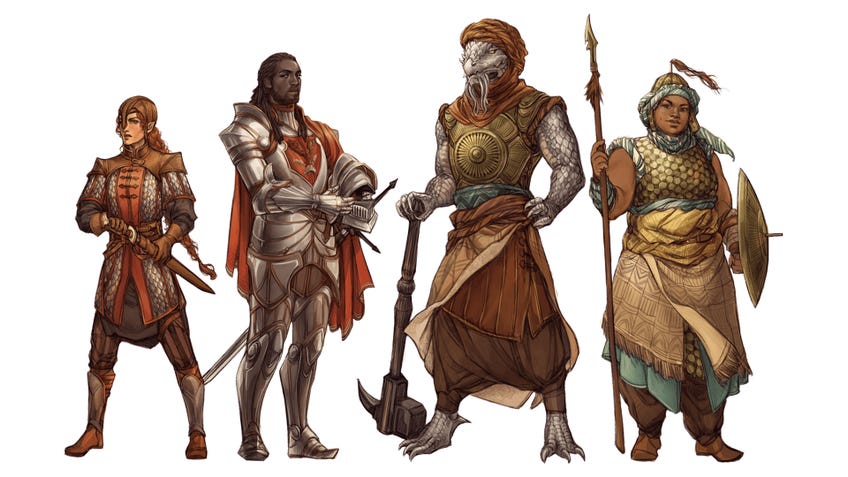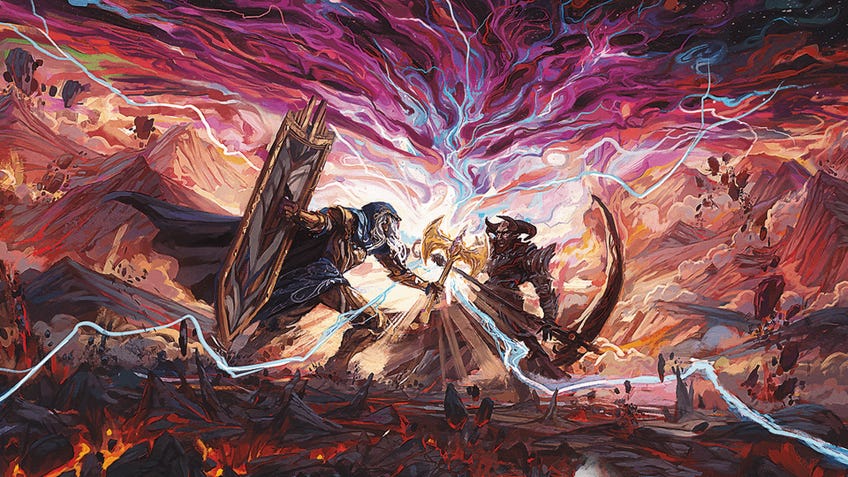Explorer’s Guide to Wildemount is the most worthwhile D&D 5E book yet, whether you’re a Critical Role fan or not
Im-Mercer yourself.
I’ve been a fan of Critical Role, the Dungeons & Dragons 5E actual play series, for a good few years now. I discovered the show late one night after a very long shift at HMV, and was instantly drawn into the world Matthew Mercer - Critical Role dungeon master and professional voice actor - had created. Of course, it helped that the cast of characters was so well-defined and that the voice actors playing them were incredibly charismatic. But it was Mercer’s detailed world-building that really made Critical Role’s campaigns feel on another level when compared with the more amateur examples my friends and I had cooked up in the past.
Granted, according to the foreword of Explorer’s Guide to Wildemount - the new D&D 5E sourcebook based on the world of Critical Role - Mercer has been running Dungeons & Dragons campaigns since his freshman year at high school. In other words, he’s no journeyman when it comes to creating immersive roleplaying worlds. Even so, Guide to Wildemount, for which Mercer served as lead writer, reads like the masterwork of someone who clearly knows how to imagine entire believable societies, provinces, pantheons, magic systems and more, at the drop of a hat.
A lot of this is thanks to the almost pedantic amount of detail included in this sourcebook; from the story of how Wildemount was first formed to the various contraband items players can attempt to smuggle from the eastern seaboard of Blightshore, there’s plenty for both DMs and players to be inspired by. The dizzying amount of lore is a lot for a D&D enthusiast to digest, let alone anyone approaching learning how to play Dungeons & Dragons 5E for the first time. It’s a fact that watching a group of well-trained actors play Dungeons & Dragons is easier than attempting to play it yourself, and I wouldn’t be at all surprised if a large number of people picking up Explorer’s Guide to Wildemount hadn’t yet dipped their toe in the murky waters of D&D 5E.

Critical Role may be accessible enough for anyone with any level of D&D experience to watch, but it’s certainly not as easy to create a homegrown campaign on the same scale as those seen on the show. The scope of Mercer’s world is truly enormous; it’s obvious how reverent he is of the legacy of Dungeons & Dragons, particularly its long history of providing immersive settings such as the hellish Avernus and steampunk Eberron. But those fresh-faced Critical Role fans who excitedly open the pages of Explorer’s Guide to Wildemount expecting a lighthearted romp through the show’s world and beginner-friendly introduction to adventuring in D&D may find themselves overwhelmed by paragraphs and paragraphs of text on long-dead rulers, once-forgotten deities and the trading habits of countless cities.
The continent of Wildemount is made up of several different regions - Menagerie Coast, Marrow Valley, Zemni Fields, Greying Wildlands, Eiselcross, Wastes of Xorhas and Blightshore - which in turn, contain several different areas ranging from cosmopolitan coastal cities like Zadash to the sun-baked wastes of Xhorhas. There’s certainly no lack of variety on display when it comes to Wildemount’s landscapes and, for the most part, the sourcebook provides some incredibly well-realised places for DMs to utilise and players to visit - down to listing elements like populations, local authorities and more. (Which have admittedly never been something I’ve ever thought about, or ever wanted to think about, when roleplaying.)
I was most intrigued by the weirder examples of world-building found in the Wildemount Gazetteer - the section that covers the setting’s geography. Take the group of people called the Wormkin, who survive by eating the ever-replenishing flesh of a giant evil worm. Or the aggressive trees of the Lotusden Greenwood that attack unsuspecting passersby. Or the Discworld-esque City of Urzin, which is carried around entirely on the backs of enormous tortoises. Explorer’s Guide to Wildemount is at its best when it steps away from the more traditional fantasy aspects of set-dressing and veers into the bizarre.

Another aspect of the Wildemount Gazetteer I particularly enjoyed were the various adventure ideas included with many of the cities and larger areas. Being a dungeon master is hard, especially when attempting to wrangle a workable campaign out of a sourcebook as daunting as Explorer’s Guide to Wildemount, so providing solid jumping-off points for campaign creators to use - including specific NPCs and entire narrative threads - is a masterstroke. I’ve always struggled with adapting complex world systems into playable campaigns, especially when it comes to designing the specifics, so I personally appreciated this touch.
A similarly practical aspect in Explorer’s Guide to Wildemount is the Heroic Chronicle, a tool entirely unique to the sourcebook. Far superior to the shallow backgrounds available when creating a Dungeons & Dragons 5E character using the Player’s Handbook, the options included in the Heroic Chronicle are intended to generate characters that fit snugly into the world of Wildemount and so, theoretically, should feel a lot more satisfying to play when using the book. It’s a fantastic idea, one that D&D publisher Wizards of the Coast should continue to implement in future D&D sourcebooks.
Explorer’s Guide to Wildemount contains arguably two major points of narrative interest: the war between the Dwendalian Empire and the Kryn Dynasty, and the revival of the betrayer gods to the mortal plane. The Mighty Nein - the motley crew currently making their way through Wildemount in season two of Critical Role - have encountered both these plotlines at various points in their adventures. I find the deities a far more interesting subject for roleplay than an enormous turf war, with Explorer’s Guide to Wildemount featuring a wide variety of gods for player characters to worship and fear. For fans of craft and knowledge there’s the mighty Dwarven deity Moradin, while for those drawn to darker devices there’s the chaotically evil Tharizdun and many more besides. Having these gods play a pivotal role in the story of Wildemount, rather than being restricted to flavour text, gives the sourcebook a distinctive tone that undoubtedly stems from Mercer’s love of diverse and interwoven pantheons. As a classical studies nerd, I can entirely relate.

As a fan of Critical Role, I could also appreciate the inclusion of various references to the members of the Mighty Nein and the various NPCs brought to life by Mercer, such as affable Zadash merchant Pumat Sol, and even characters from the first-season adventures of Vox Machina - look out for the mention of Taryon Darrington and his non-for-profit adventuring group, the Darrington Brigade. Despite these moments of fan service scattered throughout the sourcebook, Explorer’s Guide to Wildemount is still perfectly suitable for Dungeons & Dragons 5E dungeon masters and players who aren’t followers of Critical Role. It speaks to the strength of Mercer and company’s world-building that Explorer’s Guide to Wildemount very much feels like its own setting - one that could have been immortalised in a D&D sourcebook without the existence of Critical Role.
This is clearest in the addition of several new subraces for players to choose from, including pallid elves, who gain the ability to use the spell Light at first level; sea elves, who can breathe underwater; and the Lotusden halflings, who can use druidcraft from first level, regardless of their class. These subraces are included alongside summaries of every race not found in the Dungeons & Dragons 5E Player’s Handbook - such as genasi, aarakocra and aasimar - making Explorer’s Guide to Wildemount an excellent D&D sourcebook in regards to the amount of practical content it provides.
Explorer’s Guide to Wildemount introduces a new subclass, the Echo Fighter, which enables players to create a character capable of making multiple versions of themselves they can use to distract enemies and even sacrifice to provide aid.

Two never-before-seen schools of magic are also featured in Explorer’s Guide to Wildemount. Chronurgy magic allows the user to cast spells that can bend the flow of time and force other characters, and even other players, to reroll their dice. Meanwhile, graviturgy enables casters to manipulate gravity and do things like reduce the weight of entire creatures with a single spell.
Add to above four fully-designed adventures that cover a range of tones, from political intrigue to exotic horror; a complete glossary of treasures for DMs to use in their campaigns - such a series of demonic artifacts including a sword that can speak to whoever wields it - and, finally, a bestiary that introduces a collection of positively grotesque creatures for players to encounter. This includes something called an Aeorian Nullifier, which looks like an even more warped version of the absorbaloth from that one episode of Doctor Who.
That’s a whole lot of content stuffed into a single book. In fact, it’s enough for me to feel that Explorer’s Guide to Wildemount is the most worthwhile Dungeons & Dragons 5E sourcebook Wizards of the Coast has released since the original Player’s Handbook. It’s not just because of the practical tools on offer - some people could argue that other Dungeons & Dragons 5E sourcebooks provide more subclasses, spells, treasures and monsters - but as the result of the staggering variety of cities, cultures, religions, societies and histories on display here.
Explorer’s Guide to Wildemount is a lot to digest, so I wouldn’t recommend it to Critical Role fans as the first D&D sourcebook they pick up. However, if you are a Critter with a bit of Dungeons & Dragons experience already under your belt, Explorer’s Guide to Wildemount is, for all intents and purposes, the perfect sourcebook for creating and playing adventurers in Mercer’s world. Even if you aren’t a Critical Role fan, this is a remarkable D&D 5E sourcebook that should provide more than enough creative spark for your next big campaign.









